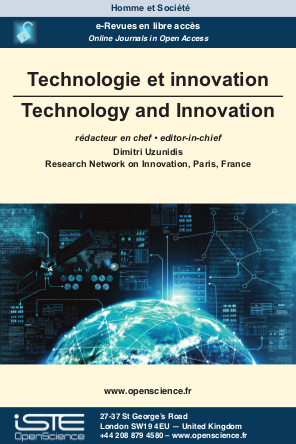

Social Sciences and Humanities > Home > Technology and Innovation > Issue
In this new issue of Technology and Innovation, five articles question the contribution of audiovisual fiction to the world of technological imagination. Innovation processes take advantage of these fictional representations to shed light on the ethics of future engineers, but also of practitioners, whether they are of the military or researchers in the telecommunications sector. Technology in science fiction is ambivalent, often depicting the worst in a dystopian form, whilst also influencing innovators, whose productions are not always at the service of sustainable development. A question also guides this issue: is audiovisual fiction at the service of ethical, sustainable innovation, or does it risk leading the strategists of capitalism and R&D towards desires that will cause harm to the human race?
Our goal is to show how science fiction films depict threats exposed in an all-digital society. These cinematographic worlds allow us to question the interest of such innovations. They paint a picture of a world in which the dematerialization of activities leads to a loss of control over them. This would make us run the risk, in the long term, of being deprived of our human qualities. However, we also show that these films do not question the viability of this type of society. Indeed, these fictional stories do not interrogate the constraints that these innovations would pose on the environment. Faced with the ecological crisis, the grip that digital technology has on society as a whole, far from appearing as a solution, risks being identified as part of the problem.
Audio-visual science fiction has recently gained a growing interest from innovation practices and communities. This is because they present, with a high level of detail, innovative technologies, all whilst softly spreading the idea of their existence into society (KIR 10). Through analyzing Steven Spielberg’s Ready Player One (2018), a film that is particularly relevant in this matter, and metaverse technologies, this article aims to verify the quality and level of responsibility of innovations displayed in the film. The audit is based on the 5F grid (five focus) which covers the different levels, beyond that of artefacts and uses, on which responsible innovation must position itself, define its purpose and demonstrate its real value. The diagnostic shows important shortcomings behind the film’s fascinating spectacle, and recalls how fiction and entertainment are also instruments of power. In conclusion, the 5F grid proves to be a useful canvas to complete and make more robust an innovation approach inspired by science-fiction, all while facilitating the input of other disciplines such as foresight, design and anthropology, which is also currently inspiring innovation practices.
This paper explores the power of science fiction stories in their role as projections and warnings, and how they can be used in an educational sense, specifically in engineering schools. We explore how to use these narratives in order to aid students reach the third level of technical culture; this involves the “art of diversion”, which allows us to encourage students to reflect on their own role when it comes to ethics and politics . This reflection also helps students think about the way technology changes the world. In this paper we first define what the third level of technological culture is and then, using three examples of contemporary sci-fi TV shows, demonstrate what could be developed and to what pedagogical end.
This paper presents the way in which fiction can be used within the framework of an innovation project, in particular an innovation project with a long-term perspective. We first present the role of fictional worlds and the way in which their mapping by lineages allows us to understand the evolution of forms, technologies and uses for products or services. We then explain, whilst highlighting the example of the French army’s Red Team Defense, how fictional productions can become performative, or how they can have an impact on a given audience.
Corporate science fiction consists of producing prospective videos featuring new services or technological innovations. Between 1997 and 2003, France Telecom R&D produced dozens of prospective scenarios, imagining the telecommunications technologies of the future. This article presents the history and characteristics of this original project thanks to the testimony of actors involved in the production of these short films. Moreover, in this article we view audiovisual fiction in a historical perspective by considering the extent to which they anticipate the emergence of design fiction, which is a creative technique that takes inspiration from science fiction to prototype new objects. Several iconic videos have demonstrated their ability to anticipate by several years major innovations such as telepresence, smartphones, voice control applications and many other Internet- and virtual-related technologies. These films essentially play an evangelistic role and have been used to test new concepts with future users.

2024
Volume 24- 9
Issue 12023
Volume 23- 8
Issue 12022
Volume 22- 7
Issue 12021
Volume 21- 6
Issue 12020
Volume 20- 5
Issue 12019
Volume 19- 4
L’innovation agile2018
Volume 18- 3
Issue 42017
Volume 17- 2
Mobility Innovations. Transport, management of flows and territories2016
Volume 16- 1
Issue 1